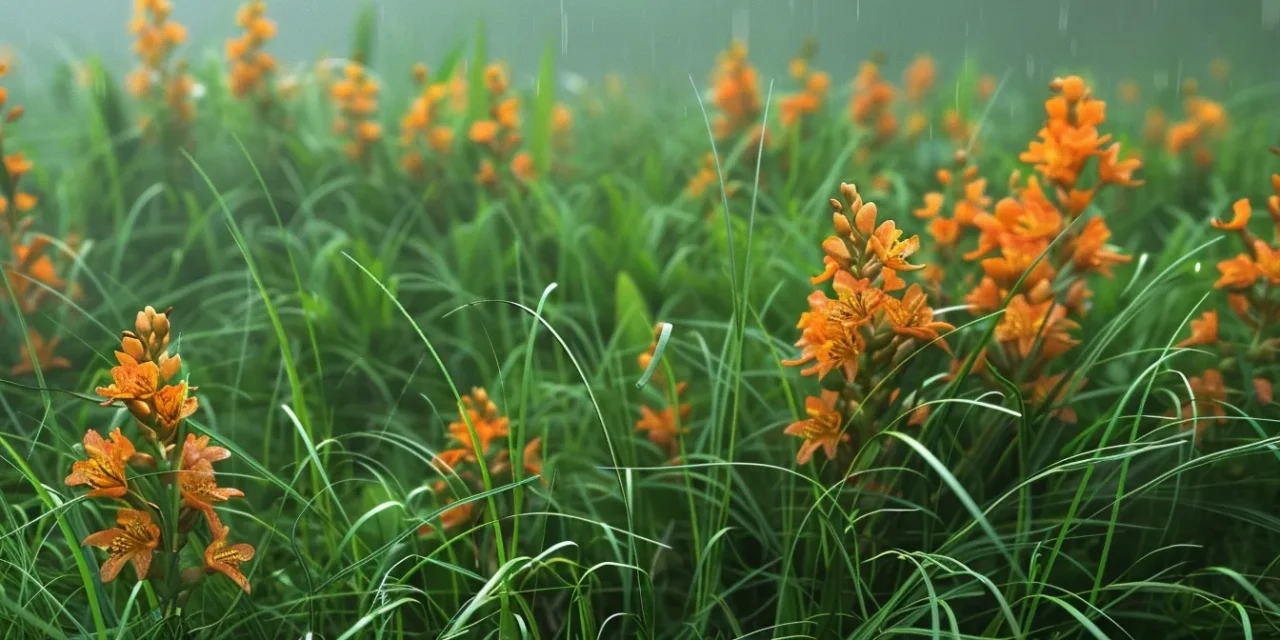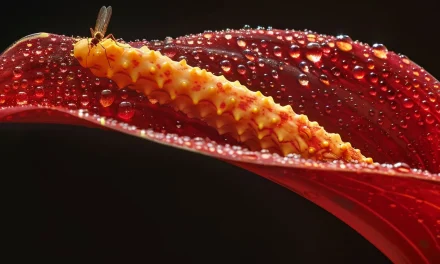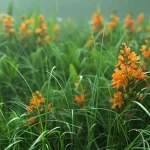Broomrape, a parasitic plant that grips its host with an iron hold, poses a hidden yet significant challenge to crops, particularly those in the Poaceae family. The complex ecology of this pest calls for proficient identification and tailored control strategies. In this post, we’ll delve into the specifics of recognizing broomrape presence, understanding its impacts on agriculture, and implementing both preventive and reactive measures to manage its spread. You’ll come away with actionable insights for safeguarding crops and mitigating the financial burdens associated with this tenacious parasite. As we navigate through case studies, you’ll see real-world applications of effective control that underscore the feasibility of overcoming the broomrape menace.
What Is Broomrape? Understanding the Parasitic Plant

Broomrape, a parasitic plant devoid of chlorophyll, challenges agriculture with its unique biology and life cycle. Upon germination, it invades the root cells of host plants, siphoning nutrients to sustain itself. I’ll explore the variety of species and how their presence impacts natural ecosystems and crops. Looking ahead, we’ll examine strategies to identify and control these stealthy invaders, emphasizing their significance in the plant world and the urgency in managing their spread.
The Biology and Life Cycle of Broomrape
In my study of broomrape, a parasitic plant that preys on the roots of various crops, I have observed its complex biology. This plant lacks chlorophyll, the substance that most plants use to synthesize food from sunlight, which compels it to extract water and nutrients directly from other plants. Its life cycle begins with seed germination, triggered by specific chemicals released by the roots of its potential host, culminating in a delicate balance that significantly affects both biodiversity and agricultural productivity.
My field experiences reveal that once a broomrape seed germinates, it develops a haustorium, an organ that penetrates the host plant‘s root system. This process is silent and often unnoticeable until the damage to the host plant becomes evident. With my focus on integrated pest management, understanding this growth phase is critical because it provides a window for early intervention and prevention before the broomrape reaches maturity and begins to spread its seeds, further threatening crops and local flora, including endangered species.
Preventing the spread of broomrape relies on a thorough understanding of its life cycle, which I’ve seen benefits from a cooperative approach among farmers and ecologists. Through vigilant monitoring and swift response, ecological disruption can be minimized. The key is to adopt strategies that are considerate of preserving native plant communities, as well as protecting valuable agricultural land, which in turn upholds the integrity of the ecosystem. Advanced knowledge can guide us to employ environmentally sound practices, ensuring that control measures support the larger goal of preserving biodiversity.
Common Species and Their Characteristics
I’ve encountered various species of broomrape during ecological surveys, each with their own unique characteristics. Orobanche minor, for instance, is one species known to parasitize plants in the clover family, displaying violet-blue to yellowish flowers. Its preference for a specific habitat, often in temperate regions, makes it a less common but noteworthy species. When examining these plants, their telltale flowering structures serve as a clue for identification, crucial for implementing timely control measures.
In my consultations with agricultural clients, I emphasize the significance of the species Orobanche crenata, which targets legumes, specifically those in the Vicia genus. As a flowering plant, the beauty of Orobanche crenata‘s flowers belies the threat it poses to crops like fava beans, potentially devastating yields. Knowledge of the plant‘s affinity for particular crops and habitats guides the development of targeted herbicide application strategies, an integral component of my recommendations for broomrape management.
While some broomrape species are relatively rare, others like Phelipanche ramosa pose significant threats to a wide range of host plants, underscoring their adaptability. Having observed these plants across different environments, I’ve noticed their persistence even in the presence of chemical controls, indicating a need for integrated management practices. My ongoing research into sustainable herbicide use and alternative management options aims to provide farmers with effective tools to tackle these resilient parasites without compromising the health of their soil or surrounding ecosystems.
How Broomrape Affects Host Plants
My research into the impact of broomrape on host plants reveals that once the haustorium—the parasitic organ of broomrape—penetrates the host‘s root system, it begins to extract vital resources. This drains the host of nutrients necessary for its growth and survival. The nutrient theft can lead to weakened plant defenses, stunted growth, and, in severe cases, the death of the perennial host plant. This deleterious effect is particularly evident in agricultural settings where broomrape invasion can result in significant crop yield losses.
In my field observations, I have seen the impact of broomrape’s parasitic behavior manifest as reduced seed production in the host plants. The acid test for determining the extent of broomrape damage lies in the visible decline in the host‘s ability to reproduce. This decline not only hampers plant population growth but also decreases genetic diversity, which can have long-term ecological repercussions beyond the immediate agricultural concerns.
The challenge in combating broomrape lies in its stealthy nature. My work in agricultural consultancy has underscored the importance of early identification and swift control strategies. Agriculturalists must often employ a combination of herbicide application and crop rotation to disrupt broomrape’s lifecycle and protect their crops. Without these measures, the parasitic invasion can go unchecked, compounding the harm to both perennial and annual host plants across diverse ecosystems.
Now we’ve grasped the nature of broomrape, silent and unseen in its workings. Let us turn to spotting the stealthy invader hidden within our crops.
Identifying Broomrape Infestations

In my fieldwork assessing broomrape risks, recognizing the early signs of infestation is paramount. Visual symptoms in crops are often the first indicators, with host plants such as those in the Lamiales order—including significant vegetables—commonly falling victim to the stealthy Orobanche ludoviciana. Recognizing the taxonomy and genetics underpinning broomrape’s choice of hosts aids in prediction and prevention. Seasonal patterns of broomrape emergence guide my tailored advice to land managers, addressing timely interventions.
Visual Signs and Symptoms in Crops
During my assessments of crop health, I often come across the initial signs of Broomrape infection that farmers might miss. One clear symptom is a marked discoloration or wilting of leaves which may mistakenly be attributed to other pathogens or water stress. In the case of the notorious Orobanche crenata, these symptoms are particularly prevalent in leguminous plants like fava beans, often decimating harvests if left unchecked.
In my experience, plants from the family Orobanchaceae, including Broomrape, often choose their hosts in prairie environments where abundant potential targets thrive. Here, Broomrape can be spotted as brown or yellowish growths at the base of a plant, differing from normal root structures. This parasitic presence is a signal to look closely – a signal that an infestation could be sapping vitality from the crop beneath the soil‘s surface.
Time and again, I’ve seen the stealthy Orobanche crenata emerge from the ground, near the root zones of its host. A vigilant eye may notice unnatural growth on the roots—a clear sign of this parasitic invasion. These visual cues, when identified early, allow us to develop precise strategies to combat and control the spread of this highly specialized pathogen before it inflicts irrevocable damage on the crop yield.
Host Plants Commonly Targeted by Broomrape
In my professional experience, Broomrape species show a strong penchant for parasitizing specific host plants, with Artemisia being a prime taxon under siege. Artemisia plants, with their array of nutrients and diverse habitats, become prime targets for Broomrape’s parasitic needs. The challenge in infestations within these hosts highlights the necessity for ecologists and agriculturists to form a united front, discerning and disrupting Broomrape’s lifecycle to protect these ecologically vital plants.
Vicia faba, commonly known as fava bean, is another crop that frequently finds itself a victim of Broomrape infestation. The nutrient-rich roots of Vicia faba provide a substantial resource for Broomrape, resulting in severe nutrient depletion, a problem I often witness in the field. The knowledge of Vicia faba’s susceptibility to Broomrape empowers farmers to prioritize monitoring and implement preemptive control measures to safeguard their crops and sustain yield levels.
Tomatoes, economically significant to growers globally, also fall prey to Broomrape. The vigor with which Broomrape targets tomatoes has been evident in the diminished vitality of infected crops I’ve encountered. Recognizing the early signs of Broomrape in tomato fields—such as sudden plant wilting and nutrient deficiency—is critical for growers to maintain the delicate balance of their farming ecosystems and intervene before severe damage takes hold.
Seasonal Patterns of Broomrape Emergence
As a farmer, I’ve observed that broomrape typically emerges as seedlings during early spring or late autumn, with the exact timing dependent on regional climate. These periods mark transitions in temperature and moisture, creating conducive conditions for broomrape seed germination. Being aware of these seasonal patterns can aid in early detection of parasitism, giving us a crucial edge in combating the infection before it compromises crop health.
In my professional practice, I have seen infection rates escalate when these parasites synchronize with the lifecycle of their host. For example, broomrape seedlings often appear when warmth triggers the host‘s growth spurt, thereby maximizing their parasitic efficiency. As a result, a disease management plan must incorporate seasonal surveillance to intercept broomrape during these vulnerable growth phases of host plants.
Utilizing my expertise, I always advise farmers to conduct thorough field inspections following soil disturbance events, such as ploughing, which can unearth dormant seeds, prompting a new wave of broomrape seedlings. This proactive step can significantly reduce the risk of full-blown infestations, thus protecting crops and ultimately securing yields against the threat of this pervasive disease.
Once we spot broomrape’s stealthy emergence, our thoughts turn to its toll. It’s more than a scourge in the fields—it’s a siege on our livelihood.
The Impact of Broomrape on Agriculture

The infiltration of broomrape, specifically the species Orobanche minor, into agricultural landscapes is more than a mere inconvenience. It bears significant economic consequences for farmers, directly affecting crop yield and quality. In my experience, the factors which exacerbate this threat range from certain gene expression patterns in the parasite that lead to a tenacious grip on plants like beans, to environmental conditions that favor broomrape’s proliferation. Exploring these dynamics and their implications on both crop health and water resources is crucial. In the following sections, I’ll discuss practical strategies to mitigate the challenges posed by this parasitic menace, underscoring the importance of informed actionable measures for agriculture.
Economic Consequences for Farmers
In my professional encounters with the agriculture industry, I’ve witnessed firsthand the detrimental economic consequences farmers endure due to broomrape infestations. This parasitic species seizes nutrients, seriously impairing crop health and resulting in diminished yields. Managing this pest becomes a financial burden, as it demands vigilant monitoring and often extensive investment in control measures. The presence of a resilient seed bank in the soil can prolong the impact on crops, making it challenging to eradicate the parasite completely and leading to recurring expenses for the farmers.
The necessity to adopt precise management strategies is paramount for protecting crops against broomrape species, each with a distinct preference for a genus or group of plants. When I advise farmers, the emphasis lies on interrupting the life cycle of the parasite, which includes targeted actions against germinating radicles. This is critical because once broomrape establishes itself, it can rapidly deplete the seed bank of a host crop, inevitably leading to financial losses that stem from reduced marketability and the cost of crop replacement.
Having witnessed the struggles of the farming community, I understand the imperative need for informed management strategies. Insights gained from battling broomrape show the value of timely identification of the genus-specific parasites and the implementation of proactive measures to diminish the seed bank’s potential. These indispensable methods help minimize the economic strain on farmers by preserving crop viability and fostering a more predictable and profitable agricultural operation.
Effects on Crop Yield and Quality
In my observations as an agricultural consultant, the parasitic plant Orobanchaceae, particularly Orobanchae aegyptiaca, has a profound impact on pea harvests. The relentless parasitism of these invaders significantly reduces the vigor of pea plants by hijacking their root systems, thereby impacting both yield and crop quality. This drain on resources often results in peas that are undersized or nutrient-deficient, compromising marketable standards and the economic returns of a harvest.
During my field assessments, I’ve encountered situations where broomrape infestation has not only diminished the quantity but also degraded the quality of crops. The presence of broomrape’s haustorium within the host root system can lead to deformities and disruptions in normal plant growth, which ultimately affects the consistency and appearance of produce. Such findings underscore the importance of integrating sound botany knowledge into the management of this parasitic plant to protect the livelihood of farmers.
In the realm of crop protection, it’s been my role to enlighten growers on the hidden toll broomrape takes on their yields. For instance, when Orobanchae aegyptiaca attaches to pea plant roots, it can go unnoticed until significant yield loss occurs, thus emphasizing the need for early detection and rapid response. By sharing practical experiences, I enable farmers to be vigilant and proactive, guiding them on when and how to counter this insidious threat effectively, thereby safeguarding the fruits of their labor.
Environmental Factors Contributing to Spread
In my professional analysis of broomrape propagation, I’ve found that certain environmental factors play a crucial role. For example, Orobanche fasciculata, a species prevalent in the United States, has been observed to spread more rapidly in soil conditions that favor its host plants. The soil health, including its texture and composition, can inadvertently offer a haven for broomrape seeds, maintaining their viability and leading to subsequent infestations.
I’ve noted in my fieldwork that the misuse of pesticides can inadvertently exacerbate the issue, as they may harm beneficial insects that otherwise help control the spread of broomrape seeds. It is critical to balance pesticide use with the conservation of insect populations, as these insects can disrupt broomrape’s lifecycle by preying on its seeds or pollinators, thereby helping to keep this parasitic plant in check.
Moreover, climate fluctuations have been observed to influence the dispersal of Orobanche fasciculata. In periods of extreme wetness or drought, the changes in soil moisture can affect the dormancy and germination rates of broomrape seeds. Adapting agricultural practices to these environmental cues and planning strategies accordingly is essential. Monitoring these conditions can guide timely intervention and potentially reduce the rapid spread of this challenging pest.
The blight of broomrape cripples crops silently, a specter in the fields. Here’s how we stand guard against this unseen enemy.
Preventing Broomrape Infestations

Transitioning to preventative strategies, it’s crucial to integrate steps like crop rotation and selecting broomrape-resistant plant varieties. Clover, often targeted by orobanche species, may benefit from these methods. Additionally, soil management practices tailored to California‘s varied conditions can be a deterrent against Orobanchae ramosa and other Orobanche varieties. In tandem with plant breeding efforts, suitable sanitation measures are imperative to curb the spread of broomrape seeds. Next, I’ll delve into the specific approaches that can create a robust defense against this pernicious threat.
Crop Rotation and Selection of Resistant Varieties
In my pursuit to advise on broomrape management, I’ve found that incorporating crop rotation into farming practices can disrupt the life cycle of this parasitic plant. Altering the environment in which a broomrape would typically thrive creates a challenge for its survival. For example, in sandy soils where certain vascular plants may struggle, altering the crop sequence can make the conditions less hospitable for the broomrape’s seed germination, reinforcing the natural defenses of the environment against this invasive species.
Additionally, my recommendation often includes the selection of plant varieties with genetic resistance to broomrape. The incorporation of specific genes that produce proteins adverse to the parasite’s development can be vital. By consulting reputable nurseries and research institutions, farmers can obtain seeds of vascular plants that inherently possess these protective traits, thereby minimizing the broomrape’s ability to latch onto and diminish the host plant‘s vitality.
From my field experience, I’ve learned that a practical approach to broomrape control is the application of natural environment management. Enhancing the soil‘s health and biodiversity, and choosing vascular plant species that are less likely to support broomrape’s parasitic requirements, naturally mitigates the risk. Implementing these strategies not only suppresses broomrape but also fosters a resilient agricultural ecosystem, reducing the need for chemical dependencies and preserving the native gene pool.
Soil Management Practices to Deter Broomrape
From my experience in agricultural consultancy, I recommend soil solarization as an effective soil management practice against broomrape. This involves covering the soil with a clear plastic tarp to trap solar energy, elevating soil temperature to levels that are lethal to broomrape seeds. By addressing the biology of broomrape directly, this method disrupts the haustorium formation that is essential for this invasive species to thrive, providing a non-chemical approach to control this pervasive plant disease.
Another soil management technique I advocate is the introduction of organic amendments to enhance soil health and foster beneficial microbial communities. Improved soil biodiversity can naturally suppress broomrape infestation by creating a less favorable environment for this parasitic plant. My field observations suggest that healthy soils, rich in organic matter, can deter broomrape and other Asteraceae family members that act as hosts, indirectly affecting broomrape’s lifecycle and reducing the incidence of this invasive species.
In my preventive strategy portfolio, I also prioritize meticulous sanitation to prevent broomrape spread. This entails the removal and proper disposal of infected plant material and contaminated soil, which often harbors the durable seeds of this parasitic plant. By breaking the chain of contamination, we can impede the plant disease cycle, safeguarding uninfected areas from the invasive spread of broomrape, and protecting the agricultural landscape from further damage.
Sanitation Measures to Reduce Seed Spread
In my professional practice, I’ve found that to preserve and enhance crop yield, strict sanitation measures must be implemented, especially to contain the spread of Orobanchaceae species like Orobanche uniflora. This includes rigorous cleaning of farm equipment and vehicles which may inadvertently transport the minuscule seeds from one field to another. It’s this attention to detail that can help prevent the introduction of broomrape to unaffected areas.
Additionally, I advise clients in agricultural sectors, particularly those cultivating Fabaceae family crops, to ensure thorough removal of plant debris post-harvest. Broomrape seeds can easily remain in the soil attached to discarded plant material, so disposal must be carried out with care to avoid contamination of soil and subsequent crops.
Moreover, I have observed that implementing a quarantine protocol for new plant material can significantly thwart the proliferation of broomrape seeds. This is especially true when dealing with sensitive crops like Fabaceae, where incorporating a waiting period for soil and plant material from external sources can allow for observation and any necessary remediation before the seeds take root and threaten crop yield and quality.
The battle with broomrape is not won merely by prevention. The fight continues as we arm ourselves with effective control tactics to confront this silent invader.
Control Strategies for Managing Broomrape

As we transition into discussing control strategies for managing broomrape, I’ll delve into various effective methods. Chemical control options and their precise application offer one avenue, targeting specific growth stages of this parasitic plant. Additionally, biological control methods leverage natural predators to disrupt the broomrape life cycle. And, of paramount significance, integrated pest management approaches combine these techniques with other strategies to control infestations holistically and sustainably. Each strategy serves to protect crops from this invasive species, ensuring farmers can maintain productive yields.
Chemical Control Options and Their Application
From my experience advising on broomrape management, the judicious use of pre-emergence and post-emergence herbicides can play a pivotal role in controlling this parasitic pest. It’s essential to apply these chemical treatments at specific times – typically when the broomrape is in its early growth stages and most vulnerable. This strategic application maximizes the herbicides’ effectiveness and minimizes the risk of resistance development, thus helping to ensure the continued productivity of valuable crops.
Drawing on my fieldwork, I’ve noted that certain herbicides are designed to target the haustorial connection between the broomrape and its host. When used as directed, these chemicals can sever the parasite’s lifeline without causing undue harm to the host plant. It is imperative, however, to adhere strictly to the recommended dosages and application techniques to protect the surrounding environment and mitigate any adverse effects on non-target organisms.
In my consultations, I stress that while chemical control options provide a necessary means of managing broomrape, they must be part of a broader integrated pest management (IPM) strategy. This approach includes rotating herbicide modes of action to prevent the parasite from developing resistance, a critical concern for long-term crop health and sustainability. By coupling chemical control with other methods, we can curtail broomrape infestations and support robust agricultural systems.
Biological Control Methods Using Natural Predators
In my professional capacity, I have studied the efficacy of using natural predators as a biological control method for managing broomrape infestations. Certain fungi and insects, which are naturally occurring enemies of broomrape, can significantly reduce the population of this parasitic plant. The introduction of these organisms into the ecosystem targets the vulnerable stages of the broomrape life cycle, offering a sustainable and eco-friendly alternative to chemical methods.
My experience in the field has provided insight into fungal species such as Fusarium oxysporum, which has demonstrated its potential as a biocontrol agent against broomrape. This fungus infects broomrape seeds and prevents their germination, disrupting the parasitism before it can damage the host plants. Partnering with mycologists, I’ve seen the practical application of such fungal pathogens pave the way for integrating biological controls into broader pest management strategies.
In my consultations with growers, I emphasize the importance of encouraging a diverse insect population that can prey on broomrape seeds and flowers. Beetles and weevils are examples of beneficial insects that feed on broomrape structures, naturally curbing their spread. My guidance in this area involves creating an environment conducive to these predators, such as maintaining field margins with native vegetation that supports their life cycles, thus enhancing the biological control of broomrape in a targeted and effective manner.
Integrated Pest Management Approaches
My approach to managing broomrape involves adopting an Integrated Pest Management (IPM) strategy, which combines various control methods to tackle different life stages and behaviors of the parasite. By integrating cultural practices, such as crop rotation with the application of selective herbicides, we create a multi-layered defense that disrupts the broomrape life cycle. This strategy not only controls the immediate threat but also reduces future vulnerabilities in crop health.
In my experience, accurate identification and timing are critical for IPM success. Early detection of broomrape infestation allows for targeted herbicide application, minimizing the impact on crops and non-target organisms. Coupled with biological controls, like introducing natural broomrape predators, this approach paves the way for a sustainable decrease in parasite prevalence, effectively conserving biodiversity in agricultural systems.
I’ve consistently emphasized the importance of education and collaboration among farmers in deploying IPM effectively. Sharing knowledge about broomrape’s behavior, preferred hosts, and emergence patterns equips farmers to make informed decisions. Regular group discussions and extension support can lead to a community-wide understanding of how to implement resilient farming practices against broomrape, ensuring long-term crop protection and sustainability.
We’ve covered the tactics to curb broomrape’s menace. Read on for stories of those who’ve turned the tide against this silent invader.
Case Studies and Success Stories

Turning our attention to effective broomrape management, we find a tapestry of success stories from various regions, offering rich lessons from those at farming’s front line. Both farmers and agronomists have contributed to an evolving knowledge base, advancing our combat strategies against this parasitic foe. In this section, we’ll delve into the specifics of these cases, dissect the innovations that mark today’s broomrape control strategies, and envisage how these will shape our approach in the future.
Effective Broomrape Management in Different Regions
In my professional experience, effective broomrape management often requires region-specific approaches due to diverse climatic and soil conditions. For instance, in the Mediterranean, advanced monitoring and precision agriculture techniques have been effectively employed to tackle Orobanche crenata infestations in legume crops. The integration of early detection systems and localized herbicide application has proven instrumental in curbing the spread of this parasitic plant in these climates.
Having worked closely with farmers in the Midwest of the United States, I’ve seen the success of crop rotation strategies that incorporate non-host crops such as maize. This practice disrupts the lifecycle of broomrape species such as Phelipanche ramosa, thereby reducing the seed bank in the soil. Implementing these rotational patterns over several seasons demonstrates a clear decline in broomrape incidents, enabling more sustainable farming.
Additionally, in arid regions where broomrape poses a significant challenge due to scant rainfall, like in parts of Australia, the adoption of solarization techniques has brought about pronounced improvement in controlling this pest. By covering the soil with clear plastic sheets to intensify the sun’s heat, farmers have been able to effectively reduce broomrape seed viability, marking a victory in regions battling with sparse water resources and broomrape resilience.
Lessons Learned From Farmers and Agronomists
In my engagements with farmers and agronomists, I’ve garnered invaluable insights on broomrape control. One significant lesson is the importance of proactive measures. Rather than waiting for broomrape infestations to become apparent, these professionals perform regular soil tests and plant inspections, enabling them to act swiftly at the initial signs of an outbreak and prevent widespread damage to their crops.
Through discussions with agronomists specializing in parasitic plant management, I’ve come to appreciate the necessity of an integrated approach. They stress combining various control strategies, like precise herbicide application and the fostering of natural predators, to tackle broomrape. This method has shown to decrease the parasite’s impact significantly, thus maintaining crop health and enhancing yield quality.
Conversations with those who have managed to keep broomrape at bay highlight the adaptation of farming techniques to counter this pest. They’ve adjusted planting schedules, improved crop rotations, and implemented vigilant sanitation measures to ensure their fields remain free from broomrape. Their hands-on experience demonstrates that understanding and adapting to the unique challenges of one’s agricultural environment is key to successful broomrape management.
Future Innovations in Broomrape Control Strategies
In my professional journey, I’ve come to recognize the potential of genetic engineering as a strong ally in the fight against broomrape. Future innovations may include the development of transgenic crops that are inherently resistant to broomrape infestation, thus significantly reducing the need for chemical controls. Such approaches can lead to the creation of crops that are not only resistant but can also disperse anti-parasitic agents to protect surrounding plants, providing an ecological safeguard within the agricultural landscape.
Moreover, my experiences suggest that advancements in precision agriculture can greatly benefit broomrape management. Technologies like drones equipped with multispectral imaging could soon be able to detect early signs of broomrape invasion, enabling a rapid and localized response. This would not only improve the accuracy of broomrape detection but also optimize the allocation of control resources to affected areas, thereby enhancing sustainability and reducing unnecessary interventions.
Lastly, continuing to explore the untapped potential of biological control methods forms the cornerstone of future strategies. Collaborating with biologists and engineers, I envision the development of biocontrol agents tailored to the unique characteristics of broomrape species. Such biological innovations could include naturally occurring predators or pathogens designed for specific broomrape genotypes, promising a more harmonious integration with the environment and sustained crop protection.
Conclusion
Understanding broomrape and its control is vital for agricultural sustainability and crop health, as this parasitic plant severely undermines plant vitality and yield. Employing vigilant identification methods, alongside strategic control measures such as crop rotation, resistant varieties, and soil management, is crucial in thwarting its spread. Farmers and agronomists must integrate these practices into a comprehensive management plan, leveraging both chemical and biological controls to protect ecosystems and maintain productivity. Ultimately, the successful management of broomrape hinges on a proactive, informed approach, safeguarding our valuable agricultural resources against this insidious threat.










